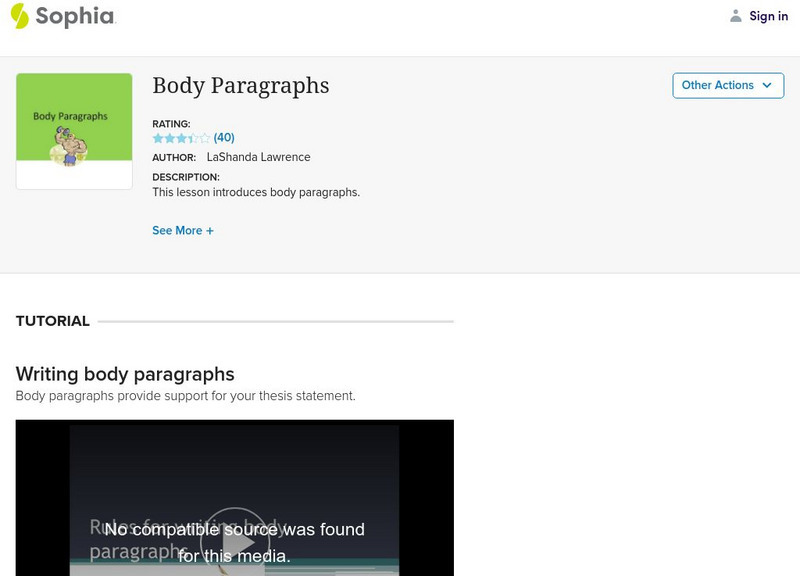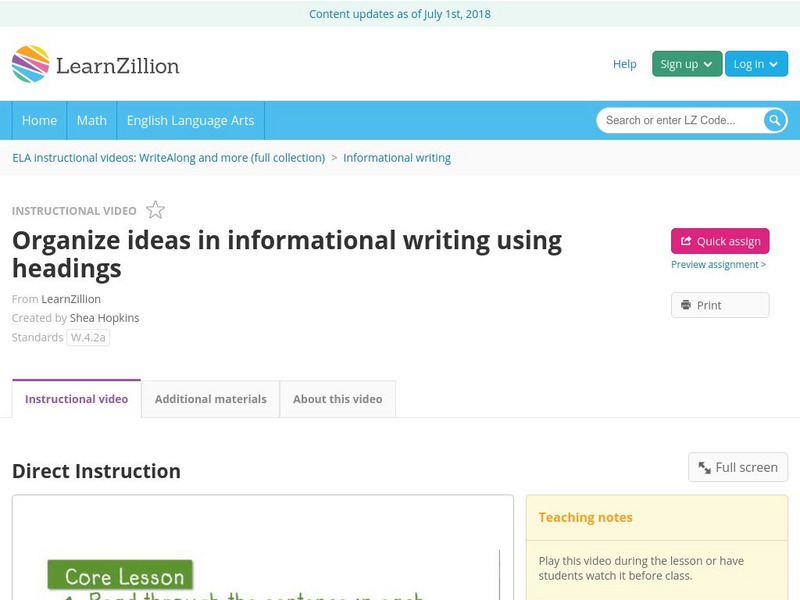Hi, what do you want to do?
Curated Video
Body Paragraph of an Informative Text | EasyTeaching
Learn how to structure a body paragraph for an informative text. In this lesson, we break down the three essential parts of a body paragraph: the topic sentence, supporting sentences, and the concluding sentence.Discover how to write...
Curated Video
A Review of Entertaining, Informative, and Persuasive Writing
Miss Palomine reviews entertaining, informative, and persuasive writing. She then shows the student examples of different kids of writing and asks the student to determine if the writing is entertaining, informative, or persuasive.
Language Tree
Language Function and Construction: Text Structure, Part 2
This lesson for beginner English learners teaches how different text types are organized to express ideas (e.g., how narratives are organized sequentially); comprehending texts and writing brief arguments, informative/ explanatory texts...
Lit2Go
The Kingdom of the Lion
If a deal sounds too good to be true, it probably is. After listening to an audio recording of Aesop's "The Kingdom of the Lion," readers discuss the moral and new vocabulary with a series of comprehension questions.
Lit2Go
The Jay and the Peacock
What determines the worth of a person? Challenge pupils to identify theme and analyze characterization with Aesop's fable "The Jay and the Peacock." Readers answer a series of comprehension questions after listening to an audio version...
Lit2Go
The Herdsman and the Lost Bull
Can ignorance sometimes be a blessing? See what your class thinks as they identify the theme of Aesop's fable "The Herdsman and the Lost Bull" and analyze character motivations within the text. The resource comes with an audiobook...
Lit2Go
The Lion and the Mouse
Have a roaring good time teaching narrative writing with Aesop's "The Lion and the Mouse.” The passage contains an audio recording that differentiates instruction for all readers with a written transcript of the story. Learners conclude...
Lit2Go
Belling the Cat
It's easy to come up with ideas, but much harder to implement them! Learners read along to an audio recording of Aesop's "Belling the Cat" before coming up with a plan that will keep the fable's mice safe while placing a bell on a cat.
Townsend Press
Relationships I
Transition words can be a very important addition to any writer's toolbox. Learn more about addition words and time words, and how they can enhance the organization of any writing passage, with an informative video about reading...
Sophia Learning
Sophia: Cause and Effect Papers
This video lesson focuses on cause and effect papers. It begins by defining the terms and purpose for cause and effect writing and then moves on to planning, organizing, and writing the paper. Real Player is required.
Sophia Learning
Sophia: Informational Writing
This video lesson focuses on informational writing including the definition, what to include, and what to leave out. W.9-10.2 Informative CCSS.ELA-Literacy.CCRA.W.2, W.11-12.2 Informative
Sophia Learning
Sophia: Argumentative Papers
This video lesson explains the purpose of argumentative papers and the construction of paper as follows: thesis states claim, evidence supports claim, identify counterargument, evidence refutes counterargument, and conclusion restates...
Sophia Learning
Sophia: Argumentative Papers: Opposing Arguments
This video lesson focuses on when and how to address opposing arguments in an argumentative paper. It begins with a warning about acknowledging opposing viewpoints and then offers a method if you choose to do so: build common ground,...
Sophia Learning
Sophia: Informational Papers
This tutorial offers 6 videos focuses on writing informative papers; the first video includes general information and the three requirements of all informative papers. The next 5 videos explain one of the following types of informative...
Sophia Learning
Sophia: Body Paragraphs
This lesson introduces body paragraphs. [3:41] CCSS.ELA-Literacy.WHST.6-8.2.b
Sophia Learning
Sophia: Comparison Papers
This lesson introduces the comparison and contrast writing, a type of informative writing. [11:46]
Imagine Learning Classroom
Learn Zillion: Draft a Concluding Paragraph That Supports Information Presented
In this lesson, you will learn how to write a concluding paragraph that supports the information presented by reviewing the topic of the essay in order to articulate its significance. [7:35]
Imagine Learning Classroom
Learn Zillion: Provide an Effective Conclusion
In this lesson, you will learn how to provide an effective conclusion by analyzing your thesis and body paragraphs. [8:19]
Imagine Learning Classroom
Learn Zillion: Grow Research Using Resources to Answer Questions
In this lesson, you will learn how to grow research for an informational text by using resources to answer your questions. [3:40]
Imagine Learning Classroom
Learn Zillion: Develop a Topic by Rereading and Grouping Related Information
In this lesson, you will learn how to develop a topic by rereading and grouping related information together in paragraphs. Login gives access to a slideshow as well. [6:14]
Imagine Learning Classroom
Learn Zillion: Organize Ideas in Informational Writing Using Headings
In this lesson, you will learn how to use paragraphs to organize ideas by introducing headings. [5:09]
Imagine Learning Classroom
Learn Zillion: Plan an Explanatory Paragraph Using a Graphic Organizer
In this lesson, you will learn how to plan an informational paragraph by completing a graphic organizer. Login gives access to a slideshow as well. [7:22]
Imagine Learning Classroom
Learn Zillion: Organize Information for an Essay Using a Graphic Organizer
In this lesson, you will learn how to organize information for an essay by using a graphic organizer. Login gives access to a slideshow as well. [8:50]
Imagine Learning Classroom
Learn Zillion: Write Body Paragraphs That Include Facts and Details
In this lesson, you will learn how to draft body paragraphs in a report by writing a topic sentence and giving supporting details. Login gives access to a slideshow as well. [8:54]


























